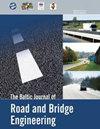使用遗产- bim建模罗马路面:庞贝的案例研究
IF 1.1
4区 工程技术
Q4 ENGINEERING, CIVIL
引用次数: 17
摘要
对古代石头路面的研究是规划和实施保护措施的必要前提。通过H-BIM获得的信息综合管理方法已应用于Via del Vesuvio,这是意大利那不勒斯庞贝考古遗址的主要道路之一。数字地形模型是使用Autodesk infrworks软件进行的。然后,使用Autodesk Civil 3D和Revit软件,对道路进行数字化,创建3D模型,其中包括现场调查得出的道路几何信息、每层路面的材料特性、施工周期和相关的施工成本信息。最后,基于文献综述中已有的研究工作,利用Autodesk Naviswork软件,可以在3D模型中实现BIM的第四维,即不同时代与Via Del Vesuvio施工相关的时间。利用所采用的BIM创作软件之间的互操作性。所采用的流程可以被认为是H-BIM石材路面技术文献中的标杆案例,突出了在设计领域的优势。本文章由计算机程序翻译,如有差异,请以英文原文为准。
Modeling Roman Pavements Using Heritage-BIM: A Case Study in Pompeii
The study of ancient stone pavements represents the necessary premise for planning and execution of treatments that considers the necessity of conservation. The approach to the integrated management of information derived through H-BIM has been applied to Via del Vesuvio, one of the main roads in the archaeological site of Pompeii in Naples, Italy. The digital terrain model was carried out using Autodesk Infraworks software. Then, using Autodesk Civil 3D and Revit software, the road was digitalized creating the 3D model that included road geometric information resulting from an on-site survey, material characteristics for each pavement layer, construction period and related construction cost information. Finally, based on the existing research works available in the literature review, using Autodesk Naviswork software, it was possible to implement in the 3D model the BIM fourth dimension, namely, the time related to the construction of Via Del Vesuvio in different eras. The interoperability between the adopted BIM authoring software was exploited. The adopted procedure can be considered a benchmark case in the technical literature of H-BIM for stone pavements, highlighting the advantages in the design field.
求助全文
通过发布文献求助,成功后即可免费获取论文全文。
去求助
来源期刊
CiteScore
2.10
自引率
9.10%
发文量
25
审稿时长
>12 weeks
期刊介绍:
THE JOURNAL IS DESIGNED FOR PUBLISHING PAPERS CONCERNING THE FOLLOWING AREAS OF RESEARCH:
road and bridge research and design,
road construction materials and technologies,
bridge construction materials and technologies,
road and bridge repair,
road and bridge maintenance,
traffic safety,
road and bridge information technologies,
environmental issues,
road climatology,
low-volume roads,
normative documentation,
quality management and assurance,
road infrastructure and its assessment,
asset management,
road and bridge construction financing,
specialist pre-service and in-service training;

 求助内容:
求助内容: 应助结果提醒方式:
应助结果提醒方式:


